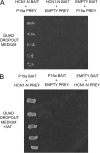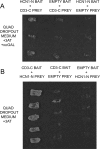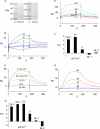Calcium-dependent binding of HCN1 channel protein to hair cell stereociliary tip link protein protocadherin 15 CD3
- PMID: 19008224
- PMCID: PMC2631981
- DOI: 10.1074/jbc.M806177200
Calcium-dependent binding of HCN1 channel protein to hair cell stereociliary tip link protein protocadherin 15 CD3
Abstract
The cytoplasmic amino terminus of HCN1, the primary full-length HCN isoform expressed in trout saccular hair cells, was found by yeast two-hybrid protocols to bind the cytoplasmic carboxyl-terminal domain of a protocadherin 15a-like protein. HCN1 was immunolocalized to discrete sites on saccular hair cell stereocilia, consistent with gradated distribution expected for tip link sites of protocadherin 15a. HCN1 message was also detected in cDNA libraries of rat cochlear inner and outer hair cells, and HCN1 protein was immunolocalized to cochlear hair cell stereocilia. As predicted by the trout hair cell model, the amino terminus of rat organ of Corti HCN1 was found by yeast two-hybrid analysis to bind the carboxyl terminus of protocadherin 15 CD3, a tip link protein implicated in mechanosensory transduction. Specific binding between HCN1 and protocadherin 15 CD3 was confirmed with pull-down assays and surface plasmon resonance analysis, both predicting dependence on Ca(2+). In the presence of calcium chelators, binding between HCN1 and protocadherin 15 CD3 was characterized by a K(D) = 2.39 x 10(-7) m. Ca(2+) at 26.5-68.0 microm promoted binding, with K(D) = 5.26 x 10(-8) m (at 61 microm Ca(2+)). Binding by deletion mutants of protocadherin 15 CD3 pointed to amino acids 158-179 (GenBank accession number XP_238200), with homology to the comparable region in trout hair cell protocadherin 15a-like protein, as necessary for binding to HCN1. Amino terminus binding of HCN1 to HCN1, hypothesized to underlie HCN1 channel formation, was also found to be Ca(2+)-dependent, although the binding was skewed toward a lower effective maximum [Ca(2+)] than for the HCN1 interaction with protocadherin 15 CD3. Competition may therefore exist in vivo between the two binding sites for HCN1, with binding of HCN1 to protocadherin 15 CD3 favored between 26.5 and 68 microm Ca(2+). Taken together, the evidence supports a role for HCN1 in mechanosensory transduction of inner ear hair cells.
Figures











Similar articles
-
HCN1 and HCN2 proteins are expressed in cochlear hair cells: HCN1 can form a ternary complex with protocadherin 15 CD3 and F-actin-binding filamin A or can interact with HCN2.J Biol Chem. 2012 Nov 2;287(45):37628-46. doi: 10.1074/jbc.M112.375832. Epub 2012 Sep 4. J Biol Chem. 2012. PMID: 22948144 Free PMC article.
-
Cyclic nucleotide-gated channel α-3 (CNGA3) interacts with stereocilia tip-link cadherin 23 + exon 68 or alternatively with myosin VIIa, two proteins required for hair cell mechanotransduction.J Biol Chem. 2013 Mar 8;288(10):7215-29. doi: 10.1074/jbc.M112.443226. Epub 2013 Jan 17. J Biol Chem. 2013. PMID: 23329832 Free PMC article.
-
Hyperpolarization-activated, cyclic AMP-gated, HCN1-like cation channel: the primary, full-length HCN isoform expressed in a saccular hair-cell layer.Neuroscience. 2003;118(2):525-34. doi: 10.1016/s0306-4522(02)00913-2. Neuroscience. 2003. PMID: 12699787
-
Beyond Cell-Cell Adhesion: Sensational Cadherins for Hearing and Balance.Cold Spring Harb Perspect Biol. 2018 Sep 4;10(9):a029280. doi: 10.1101/cshperspect.a029280. Cold Spring Harb Perspect Biol. 2018. PMID: 28847902 Free PMC article. Review.
-
Tip links in hair cells: molecular composition and role in hearing loss.Curr Opin Otolaryngol Head Neck Surg. 2009 Oct;17(5):388-93. doi: 10.1097/MOO.0b013e3283303472. Curr Opin Otolaryngol Head Neck Surg. 2009. PMID: 19633555 Free PMC article. Review.
Cited by
-
The how and why of identifying the hair cell mechano-electrical transduction channel.Pflugers Arch. 2015 Jan;467(1):73-84. doi: 10.1007/s00424-014-1606-z. Epub 2014 Sep 23. Pflugers Arch. 2015. PMID: 25241775 Free PMC article. Review.
-
HCN channels in the mammalian cochlea: Expression pattern, subcellular location, and age-dependent changes.J Neurosci Res. 2021 Feb;99(2):699-728. doi: 10.1002/jnr.24754. Epub 2020 Nov 12. J Neurosci Res. 2021. PMID: 33181864 Free PMC article.
-
Molecular Structure of the Hair Cell Mechanoelectrical Transduction Complex.Cold Spring Harb Perspect Med. 2019 May 1;9(5):a033167. doi: 10.1101/cshperspect.a033167. Cold Spring Harb Perspect Med. 2019. PMID: 30082452 Free PMC article. Review.
-
Calcium regulates molecular interactions of otoferlin with soluble NSF attachment protein receptor (SNARE) proteins required for hair cell exocytosis.J Biol Chem. 2014 Mar 28;289(13):8750-66. doi: 10.1074/jbc.M113.480533. Epub 2014 Jan 29. J Biol Chem. 2014. PMID: 24478316 Free PMC article.
-
Are TMCs the Mechanotransduction Channels of Vertebrate Hair Cells?J Neurosci. 2016 Oct 26;36(43):10921-10926. doi: 10.1523/JNEUROSCI.1148-16.2016. J Neurosci. 2016. PMID: 27798174 Free PMC article.
References
-
- Cho, W. J., Drescher, M. J., Hatfield, J. S., Bessert, D. A., Skoff, R. P., and Drescher, D. G. (2003) Neuroscience 118 525-534 - PubMed
-
- Holt, J. R., and Eatock, R. A. (1995) J. Neurophysiol. 73 1484-1502 - PubMed
-
- Ramakrishnan, N. A., Drescher, M. J., and Drescher, D. G. (2007) Assoc. Res. Otolaryngol. Abstr. 30 31
-
- Proenza, C., Angoli, D., Agranovich, E., Macri, V., and Accili, E. A. (2002) J. Biol. Chem. 277 5101-5109 - PubMed
Publication types
MeSH terms
Substances
Grants and funding
LinkOut - more resources
Full Text Sources
Molecular Biology Databases
Research Materials
Miscellaneous

